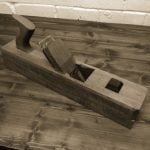Making a breasted saw?
Welcome! / Forums / General Woodworking Discussions / Tools and Tool Maintenance/Restoration / Making a breasted saw?
- This topic has 6 replies, 5 voices, and was last updated 4 years, 7 months ago by
Alan.
-
AuthorPosts
-
3 December 2019 at 6:50 pm #633075
I recently purchased a large toothed rip saw (26″, ~4-5 tpi).
The tooth line is rather convex. When standing it upright on its teeth on a flat surface, the teeth in the middle are about 3-4mm above the toe and heel.
Since this needs to be fixed anyway, would it be worth the extra work to add breast to the saw, instead of just straightening it?
If yes, how much should I add? 3 December 2019 at 11:01 pm #633130
3 December 2019 at 11:01 pm #633130My breasted PAX handsaws are, to me, not superior to a £7 no-name straight one, nor to the also straight Lie-Nielsen hand saws or Bad Axe Tool Works bespoke 26″ D8 replica.
There are two great unanswered mysteries about saws; one is “why are teeth breasted?”, the other is, “what’s the purpose of the nib?”
No doubt you’ll get conflicting opinions…. some folk use breasted saws others don’t.
Perhaps it’s a traditional thing that’s always been done. If there’s an advantage in using a breasted plate, it’s evaded me. Allegedly it assists the progress of the ergonomic stroke on coarse cross-cut work, that’s the theory, anyway.Personally, all my saws are rescues gathered over many years, many I have stripped and restored and re-toothed and all are straight because that’s the way I work.
I’m assuming that you do your own saw-doctoring. If the teeth on your saw are all in good order without gaps in the line of the tips, curved or straight and you can use and sharpen it without issues, then leave it as is, carrying on with the breast. There may be a good reason why the original owner chose that configuration that becomes obvious when you use it. With those teeth sizes, it may be worth checking that the fleam along its length is the same.
Alternatively, if the whole thing needs to be stripped back and the teeth re-cut, it is likely to be a lot easier dealing with a straight line of teeth than introducing a new breasted line.
If you need to restore the breasted line later you can then do so; it is easier in terms of work to add a breast line, working either side of the crown to the heel and toe of the saw than to remove it. You also have the option of positioning the breast-crown where it suits your arm-stroke – it doesn’t have to be in the middle of the plate.As for for the reason there’s a nib……… or not….. any answers? I’m writing a book on the subject.
Good luck!Saws often had wooden guards to cover and protect the teeth. These guards were tied in place with a simple length of string. One loop of string from guard to Hook, another loop from guard to Nib. The Nib being used as a forward anchor-point for that string, preventing it from slipping off the skewed back.
I’ve no idea how accurate this theory is, but it seems quite plausible to me.
 4 December 2019 at 5:58 pm #633391
4 December 2019 at 5:58 pm #633391A breasted saw is supposed to make the use of the saw more comfortable for long sawing sessions, since it suits better to the natural swing of the arm when it comes to full length strokes. Therefore the saw has to be quite long (24 inches and above) so a full arm swing can be utilised.
A breasted saw’s intented use was either long rip cuts of relatively thick stock or crosscut of wide thick boards.
The are also supposed to cut a little bit faster because for the same straight line stroke a curved tooth line has more teeth cutting compared to a straight one.
From my personal experience there was a noticeable difference between a modern S&J 24inch 7tpi (converted) rip saw and an old Warranted Superior 26inch 6.5tpi breasted rip saw when I had to rip thick stock. The difference was even bigger when I ripped thiner boards out of a 12cm thick jarrah sleeper (both saws sharpened and set by me). The breasted saw made the sleeper ripping les tedious (but still it was hard work).
4 December 2019 at 6:21 pm #633402Thanks for the replies.
I think I will just file it straight, and see if the results are satisfying.
The teeth look quite good, except for the toothline being concave, so I don’t think they need to be recut. I’ll probably wait for a saw in worse condition before attempting that.As for the nib, a guy named Tony Zaffuto posted this brilliant theory on sawmillcreek.org:
“Personally, I know for a fact it was placed on the saw, to give a back scratching point to the saw, since many users had been using the tooth side of the blade and causing open wounds, hence creating the rounded nib. Romans were the first and in their infinite wisdom, did not know how hard users would scratch, and to give a path for blood to flow away from their togas, also put the ogee. When it was learned that the nibs were mostly bloodless, the ogee soon fell out of use, and through the middle ages, many craftsmen argued why some old saws had ogees and why the ogee disappeared.”
…and that’s how the Backsaw got its name!
Romans had a sponge-on-a-stick for the toilet, but used a saw when scratching their back?
Ask a hundred people, and you’ll get a hundred different answers. Its the same with Chip-Breaker, Frog… etc. Nailing down facts for your book is not going to be easy. -
AuthorPosts
- You must be logged in to reply to this topic.
